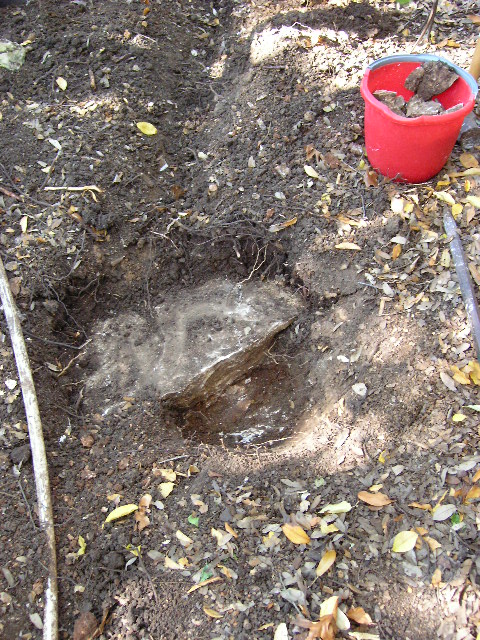Last week, I had planned on planting my second Evergreen Sumac (
Rhus virens) in this spot to accompany the one I
planted a couple of weeks ago. That time I was able to slowly pound, cuss and fracture my way through the limestone. But not this time.
Even though I immediately discovered an edge and moved the sprinkler system line, I was never able to get this rock to budge. There was no way the roots of the Evergreen Sumac would be able to grow to their needed
depth. I considered planting a Chinese Mahonia (
Mahonia fortunei) here instead, but additional digging near the edge exposed an even deeper layer of rock (the tip of the trowel rests upon it). Repeated blows from a sledgehammer and rock bar made little impact.
So I abandoned that
site and instead moved the Chinese Mahonia over to the spot where I had planned to plant another Pam's Pink Turk's Cap (
Malvaviscus drummondii 'Pam Puryear'). I will likely plant a couple more Pam's Pink Turk's Cap encircling the Chinese Mahonia - with one being farther back near my original rock-lined pit.
I am hoping that the evergreen Mahonias will make a nice backdrop to the two planted and two incoming Turk's Caps (especially since the Turk's Caps will lose their leaves in the winter). Will likely also extend my Cast Iron Plants (
Aspidistra elatior) further along the fence to provide additional year-round greenery.
This morning, I picked this spot to plant another Rattlesnake Agave (
Manfreda maculosa). I wanted to start here because I hoped it would be the least rocky location (the surface rocks were actually placed there by me - I got to do something with 'em after digging 'em up!)
 |
| Before |
Though there was a rock (grumble), it wasn't too difficult to remove. And the Rattlesnake Agave fits in nicely and will hopefully multiply as has my original planting.
 |
| After |
Continuing to plant along the back of my garden, I prepared myself for substantial rocky discoveries. Sadly, I was not disappointed. I wanted to plant two of a planned four Gold Dust Plants (
Aucuba japonica 'Variegata') here. The first hole required significant effort - so much so that I went on the the second spot to see if I could fair any better. It also had a considerable limestone presence, but at least they were of a size that, with lots of effort and rock bar torque, I could slowly pry them out of the soil.
Returning to the original spot, I removed some tree roots, then applied sledgehammer and rock bar to the stone. Over time, I was able to finally develop some cracks and pry out larger and larger chunks until I eventually broke through to the soil underneath.
 |
| Before |
I envision some large plants along the fence (possibly some variety of Oakleaf Hydrangeas) with the evergreen Aucubas providing winter foliage.
 |
| After |
 |
| Before |
 |
| After |










Wow...you've made me feel REALLY guilty about complaining about my heavy clay soil...you win!
ReplyDeleteI share your frustration at digging holes. I have so many abandoned sites. But then again, rocks are a blessing too. I would rather have them than not. Happy Thanksgiving.
ReplyDelete